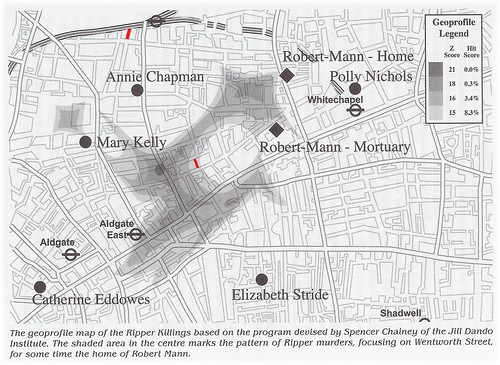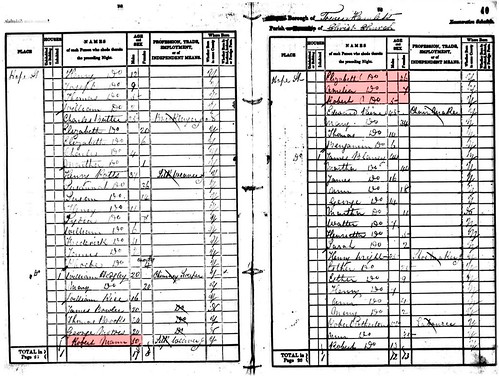"For me, this is absolutely fascinating, because the mortuary attendant, Robert Mann, was born just here. … In Hope Street! It's, it's just there! It's very much within that central area that you have profiled as being his killing zone."
M. J. Trow discussing the Geographic Profile that was conducted for the Discovery Channel documentary "Jack the Ripper: Killer Revealed".
As he points to the general area, in which 'Hope Street' was situated; the television perspective changes from a profile depiction, based on a modern underlying map, to one that is based on the 1894 Ordnance Survey. At this point, Hope Street, Parish of St. Mary Whitechapel*, is clearly visible within the vicinity, to which Mr. Trow has drawn the attention of the Geographic Profiler, with whom he is speaking.
* Why bother with the parochial distinction 'Parish of St. Mary Whitechapel', when referring to Hope Street, in this particular instance?
After all, …
… such things are really of no relevance; are they?

Geographic Profile: "Jack the Ripper: Quest for a Killer", by M. J. Trow; Page 191 (Click to Enlarge in flickr)
My Color-Shadings
Red (Top-to-Bottom / Left-to-Right):
Hope Street, Parish of Christ Church Spitalfields
Hope Street, Parish of St. Mary Whitechapel
Now, which of the two do we think might have been the early childhood home of Robert Mann?
"The census of 1841 shows the Mann family living in Hope Street, Whitechapel, on the edge of the focus of Jack's activities, as outlined by geo-profiler Spencer Chainey."
"Jack the Ripper: Quest for a Killer", by M. J. Trow; Page 187
Clearly, Mr. Trow thinks he has the answer!
Let's see for ourselves; shall we?
Census of England & Wales, 1841
County: Middlesex
Registration District: Whitechapel
Civil Parish: Christ Church Spitalfields
Registration Sub-District: Spitalfields
Enumeration District: 2
Enumeration Schedules: 36 – 42
Pages: 17 – 29
Hope Street: House Numbers not Delineated; 296 Total Residents …

Census of England & Wales, 1841: Hope Street, Parish of Christ Church Spitalfields, County of Middlesex (Click to Enlarge in flickr)
…
Enumeration Schedule: 40
Pages: 25, 26
- Robert Mann; 50; Silk Weaver
- Elizabeth Mann; 46
- Amelia Mann; 7
- Robert Mann; 5
…
Census of England & Wales, 1841
County: Middlesex
Registration District: Whitechapel
Civil Parish: St. Mary Whitechapel
Registration Sub-District: Mile End New Town
Enumeration District: 1
Enumeration Schedules: 18, 19
Pages: 27 – 29
Hope Street: House Numbers not Delineated; 46 Total Residents …
…
None by the name of 'Mann'
…

Hope Street, Parish of Christ Church Spitalfields; and Hope Street, Parish of St. Mary Whitechapel (Click to Enlarge in flickr)
Underlying Aerial Imagery: Copyright Google Earth, 2007
Overlying Plots, Labels and Color-Shadings: Copyright Colin C. Roberts, 2010
Red w/ Gold Outline (Top-to-Bottom / Left-to-Right):
- Hope Street, Parish of Christ Church Spitalfields
- Hope Street, Parish of St. Mary Whitechapel
Red w/ Green/White Outline (Bottom-to-Top / Left-to-Right):
- Whitechapel Union Infirmary Mortuary, Eagle Place, Old Montague Street, Hamlet of Mile End New Town
- Whitechapel Union Infirmary, Baker's Row, Hamlet of Mile End New Town
No less than a book and television documentary devoted to this non-starter, Robert Mann; and the folks who put it all together cannot even track down his early childhood home and possible place of birth.
Mr. Trow should have referred to the 1873 Ordnance Survey, rather than the 1894 series of the same. He wouldn't have needed John Bennett's fancy Goad Fire Insurance Survey (Provided, Courtesy of Robert Clack) to locate Eagle Place, Hamlet of Mile End New Town; and he might have noticed that there were at least two thoroughfares named 'Hope Street' in the Whitechapel Registration District: One of them being clearly situated within the Parish of St. Mary Whitechapel, and the other being well within the boundaries of the Parish of Christ Church Spitalfields.
There are some other mistakes in Mr. Trow's book that I will very eagerly address, when I am able to find the necessary amount of time:
- He suggests that the immediate vicinity of the murders, which he refers to as the 'Abyss' and the 'Ghetto', was populated in 1888, by some "450,000 lost souls"; and that ninety percent were Jewish.
Rest assured that nothing less than the entire Parliamentary Borough of Tower Hamlets was populated by 450,000 persons, in 1888; and that no more than forty percent would have been rightfully described as "lost souls".
Also, rest assured that the proportion of Jews-to-Gentiles, in the Whitechapel Registration District, in 1888, was no more than one-to-one; and that I will show good reason for believing as much.
Mr. Trow makes countless other mistakes throughout the course of his book, but admittedly, most of them are quite trivial. However, the manner, in which he justifies his presumptions that Robert Mann was able to come-and-go from the Whitechapel Union Infirmary, in 1888, is sophomoric, at best; and I will surely have more to say about it.
I have stated repeatedly, that as suspects for having been 'Jack the Ripper' are concerned; Robert Mann is a non-starter.
Well, it is time to state that as serious students of the mystery of 'Jack the Ripper' are concerned; M. J. Trow is a non-starter!
M. J. Trow discussing the Geographic Profile that was conducted for the Discovery Channel documentary "Jack the Ripper: Killer Revealed".
As he points to the general area, in which 'Hope Street' was situated; the television perspective changes from a profile depiction, based on a modern underlying map, to one that is based on the 1894 Ordnance Survey. At this point, Hope Street, Parish of St. Mary Whitechapel*, is clearly visible within the vicinity, to which Mr. Trow has drawn the attention of the Geographic Profiler, with whom he is speaking.
* Why bother with the parochial distinction 'Parish of St. Mary Whitechapel', when referring to Hope Street, in this particular instance?
After all, …
Originally posted by John Bennett
View Post

Geographic Profile: "Jack the Ripper: Quest for a Killer", by M. J. Trow; Page 191 (Click to Enlarge in flickr)
My Color-Shadings
Red (Top-to-Bottom / Left-to-Right):
Hope Street, Parish of Christ Church Spitalfields
Hope Street, Parish of St. Mary Whitechapel
Now, which of the two do we think might have been the early childhood home of Robert Mann?
"The census of 1841 shows the Mann family living in Hope Street, Whitechapel, on the edge of the focus of Jack's activities, as outlined by geo-profiler Spencer Chainey."
"Jack the Ripper: Quest for a Killer", by M. J. Trow; Page 187
Clearly, Mr. Trow thinks he has the answer!
Let's see for ourselves; shall we?
Census of England & Wales, 1841
County: Middlesex
Registration District: Whitechapel
Civil Parish: Christ Church Spitalfields
Registration Sub-District: Spitalfields
Enumeration District: 2
Enumeration Schedules: 36 – 42
Pages: 17 – 29
Hope Street: House Numbers not Delineated; 296 Total Residents …

Census of England & Wales, 1841: Hope Street, Parish of Christ Church Spitalfields, County of Middlesex (Click to Enlarge in flickr)
…
Enumeration Schedule: 40
Pages: 25, 26
- Robert Mann; 50; Silk Weaver
- Elizabeth Mann; 46
- Amelia Mann; 7
- Robert Mann; 5
…
Census of England & Wales, 1841
County: Middlesex
Registration District: Whitechapel
Civil Parish: St. Mary Whitechapel
Registration Sub-District: Mile End New Town
Enumeration District: 1
Enumeration Schedules: 18, 19
Pages: 27 – 29
Hope Street: House Numbers not Delineated; 46 Total Residents …
…
None by the name of 'Mann'
…

Hope Street, Parish of Christ Church Spitalfields; and Hope Street, Parish of St. Mary Whitechapel (Click to Enlarge in flickr)
Underlying Aerial Imagery: Copyright Google Earth, 2007
Overlying Plots, Labels and Color-Shadings: Copyright Colin C. Roberts, 2010
Red w/ Gold Outline (Top-to-Bottom / Left-to-Right):
- Hope Street, Parish of Christ Church Spitalfields
- Hope Street, Parish of St. Mary Whitechapel
Red w/ Green/White Outline (Bottom-to-Top / Left-to-Right):
- Whitechapel Union Infirmary Mortuary, Eagle Place, Old Montague Street, Hamlet of Mile End New Town
- Whitechapel Union Infirmary, Baker's Row, Hamlet of Mile End New Town
No less than a book and television documentary devoted to this non-starter, Robert Mann; and the folks who put it all together cannot even track down his early childhood home and possible place of birth.
Mr. Trow should have referred to the 1873 Ordnance Survey, rather than the 1894 series of the same. He wouldn't have needed John Bennett's fancy Goad Fire Insurance Survey (Provided, Courtesy of Robert Clack) to locate Eagle Place, Hamlet of Mile End New Town; and he might have noticed that there were at least two thoroughfares named 'Hope Street' in the Whitechapel Registration District: One of them being clearly situated within the Parish of St. Mary Whitechapel, and the other being well within the boundaries of the Parish of Christ Church Spitalfields.
There are some other mistakes in Mr. Trow's book that I will very eagerly address, when I am able to find the necessary amount of time:
- He suggests that the immediate vicinity of the murders, which he refers to as the 'Abyss' and the 'Ghetto', was populated in 1888, by some "450,000 lost souls"; and that ninety percent were Jewish.
Rest assured that nothing less than the entire Parliamentary Borough of Tower Hamlets was populated by 450,000 persons, in 1888; and that no more than forty percent would have been rightfully described as "lost souls".
Also, rest assured that the proportion of Jews-to-Gentiles, in the Whitechapel Registration District, in 1888, was no more than one-to-one; and that I will show good reason for believing as much.
Mr. Trow makes countless other mistakes throughout the course of his book, but admittedly, most of them are quite trivial. However, the manner, in which he justifies his presumptions that Robert Mann was able to come-and-go from the Whitechapel Union Infirmary, in 1888, is sophomoric, at best; and I will surely have more to say about it.
I have stated repeatedly, that as suspects for having been 'Jack the Ripper' are concerned; Robert Mann is a non-starter.
Well, it is time to state that as serious students of the mystery of 'Jack the Ripper' are concerned; M. J. Trow is a non-starter!



Comment